eFiles - CWGC Archive
Over the past year, the CWGC Archive team have been systematically cataloguing our Enquiry Files (Efiles) which document correspondence between the Commission and the next of kin of those we commemorate.
They cover a range of subjects connected to the commemoration of a war casualty, including requests for the repatriation of remains, requests for the addition of personal inscriptions to a headstone, requests for a photograph of a grave, attempts to locate a missing individual, issues regarding maintenance and upkeep of a grave, the exhumation and reburial of a casualty, and the return of wooden crosses to families.
The files are a unique record of the discussions and interactions between us and the families of those we commemorate. They are a window into how people felt at the time and the efforts of the Commission to help them.
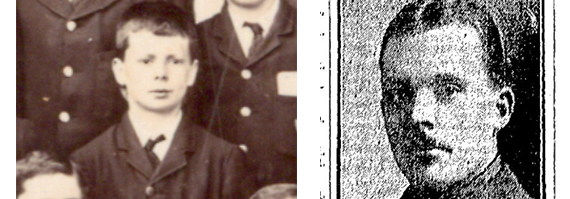
On 17 May 1918, Capt. Ralph Bell and his observer, Lt Alan Malcolm took off in their single-engined biplane to make a high-level reconnaissance flight over the lines in Belgium. They never returned.
Lieutenant Alan Alexander Malcolm and Captain William Ralph Bell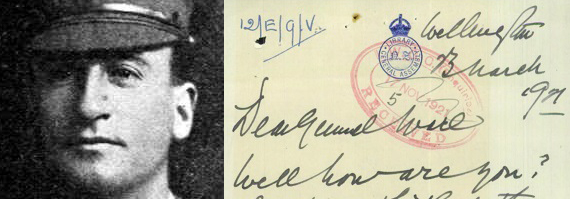
Often following the death of a loved one, families would ask to have their remains repatriated. This is the story of Captain Richard Seddon and his mother's efforts to return him to Wellington.
Captain Richard Seddon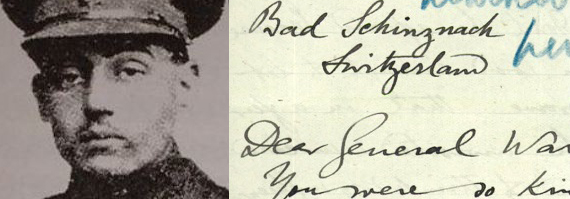
Major Cedric Dickens was the grandson of famous author Charles Dickens, but his archive files really focus on his mother, Lady Marie Dickens, and her efforts to ensure her son’s grave was looked after
Major Cedric Charles Dickens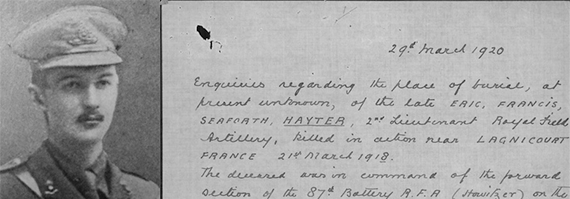
Read the fascinating story of the search for the remains of Second Lieutenant Eric Frances Seaforth Hayter whose father enlisted the help of former German soldiers and a French Countess in his search.
Second Lieutenant Eric Frances Seaforth Hayter
On 27 June 1918, Lieutenant Welinkar climbed aboard Dolphin D3691 and took off from the aerodrome at Bertangles for what would be his final patrol. His fate remained unknown for many months afterwards
Lieutenant Shri Krishna Chanda Welinkar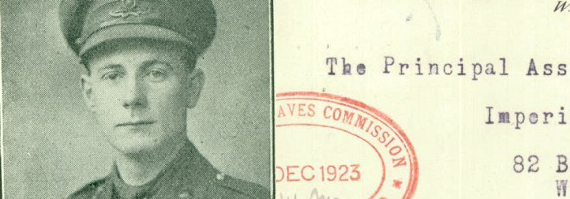
Read the story of Major George Anthony Murray and the Commission's efforts to return him to his native South Africa and to his wife Margaret.
Major George Anthony MurrayFrequently Asked Questions about our Efiles
Efiles, short for Enquiry Files, are a collection of files of correspondence, usually between the CWGC and the next of kin of a casualty commemorated by them. They can cover a range of subjects connected to the commemoration of a casualty, including requests for the repatriation of remains, requests for the addition of personal inscriptions to a headstone, requests for a photograph of a grave, attempts to locate a missing individual, issues regarding maintenance and upkeep of a grave, the exhumation and reburial of a casualty, and the return of wooden crosses to families.
The files are a record of the interactions, discussions and conversations that the CWGC had with the next of kin, and help to illustrate how it carried out its task of commemorating the war dead.
This collection of Efiles represents most, but not all, of the First World War related Efiles held in the CWGC archive. A further batch of around 1000 Efiles relating to First World War casualties is currently being catalogued by the archive team and will be released later on in the year.
While we are endeavouring to release as much material as we can to the public, a small number of First World War Efiles will have to remain closed, either because the majority of correspondence that they contain is modern, or the correspondees featured on the file could still be alive.
The CWGC archive also holds a further collection of Second World War Efiles, but these are not available to the public at the current time due to data protection reasons.
Unlike previous casualty related records released by the CWGC, such as grave registration reports and headstone schedules, Efiles do not record one moment in time but cover a period of time. The individual letters and correspondence on the files have built up over a number of years, and therefore it is much harder to assess whether Efiles can be released, or whether their release would create issues around data protection and GDPR. Each individual file needs to be looked at and assessed before a decision can be taken.
In addition, while the Efile collection had been listed by individual casualty, the topics and subject matters of the Efile had not been previously documented or catalogued. It is only in the last year that the CWGC archive team has systematically catalogued these files, providing full descriptions of the contents, and thus hopefully making them more accessible to the public.
Finally, it should also be noted that while the digitised casualty records previously available on the CWGC website usually amount to one or two individual images per record type, some Efiles can run to 700 pages, and these could not be easily displayed on the CWGC website in its current form. With the launch of the recently redeveloped CWGC archive catalogued these files can now be viewed in their entirety.
While the First World War has almost completely moved beyond the extent of living memory, the Second World War is still an event that was lived and experienced by many individuals alive today. This means that the release of records relating to casualties from the Second World War needs to be handled with care and sensitivity. Once the remaining First World War Efiles have been catalogued and released online, the CWGC archive team will begin to assess the collection of Second World War Efiles with a view to cataloguing them in a similar manner.
When that work has been completed, it is likely that certain files may be identified as being free from any data protection or GDPR issues and can be released, but this will need to be done on a case by case basis and the work could take several years to complete.
In the process of digitising and cataloguing these records, the CWGC archive team noted that some of the correspondence in the files was in the wrong date order. However, it was also recognised that these files were working documents, and various CWGC staff over the history of the organisation have used them to deal with enquiries. As a result, sometimes material in the file was moved and refiled in a different position, reflecting the working processes of the records staff at the time. It was important for us to preserve the original order of the file as it was when it came into the archive, so where we believed that the incorrect date order of material reflected a genuine process of filing we have preserved that in the digitised version.
However, it was also clear on some occasions that records had been misfiled (for example when page 2 of a letter was found several pages before page 1). Where the archive team were confident that the ordering of the records was a case of misfiling, we have attempted to correct that in the digitised version, but it is likely that given the amount of records that were scanned and digitised, some material may still be out of order.
Should you find examples of where a record appears to be misfiled, or where a page appears to be missing, please feel free to contact us at enquiries@CWGC.org and the archive team will be happy to investigate.
It is believed that the letters used in the prefixes of the file reference correspond to the names of places where there were Army record offices (e.g. CDEW (Cork, Dublin, Exeter, Warwick); HLG (Hounslow, London and Guards). Each record office served a known group of units/regiments. They were at the core of the Army’s system of maintaining service records and keeping in touch with next-of-kin. It is clear that the Efile prefix system was originally designed to match the enquiry file system of the CWGC to the Army record offices, who were of crucial importance to the early work of the Commission.
Over the course of the digitising and cataloguing process, it was noted that some of the documents in the Efiles were in a poor state of repair. The fact that such records have now been digitised is one component in helping to preserve them into the future, since they no longer need to be physically handled by staff or researchers. Each file was also assessed by the CWGC archive team during the cataloguing process and where it was recognised as being in a physically poor state it was rehoused in robust, acid-free protective archive folders.
The CWGC archive does not have a conservation department and is unable to carry out interventive work on the records, but it will be looking at ways in which these records can be further stabilised and protected for the future.
The gaps in the original file reference sequence of these records reflects the number of files that have been destroyed over the years as previously discussed above.
While we are always keen to provide access to our archives, due to the fragile nature of some of these records, and the fact that they are available in digital form, we try to discourage physical access to these files as much as possible.
Any request to access an archive Efile will be assessed by the CWGC archive team, and where there is a proven genuine need to consult the physical document we will attempt to provide access.
In the first instance these Efiles will only be accessible through the CWGC archive catalogue: http://archive.cwgc.org/
However, it is intended that this material will also be available through the normal CWGC casualty search, either as a digitised file or a direct link to the archive catalogue. Work on this is currently in hand.

